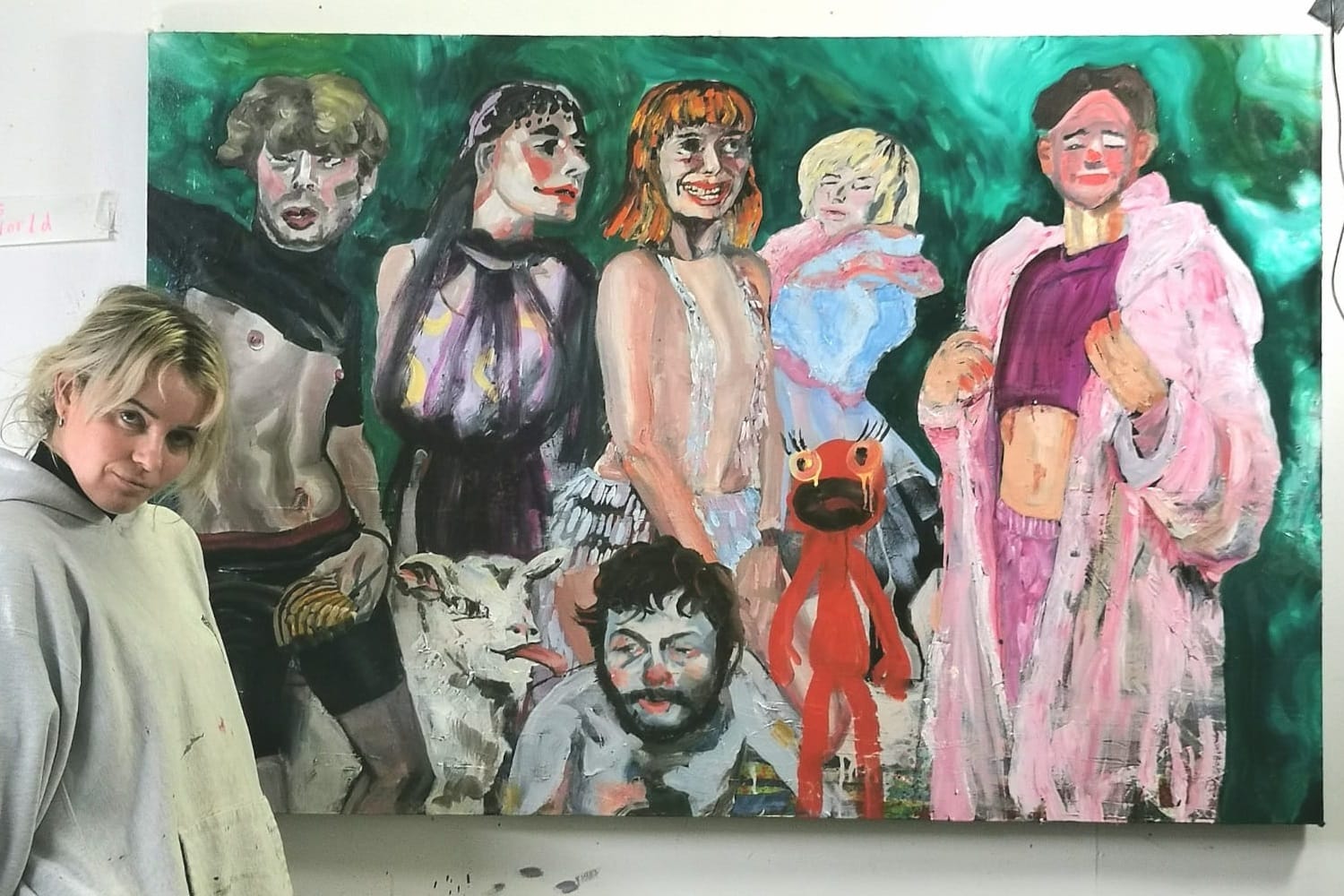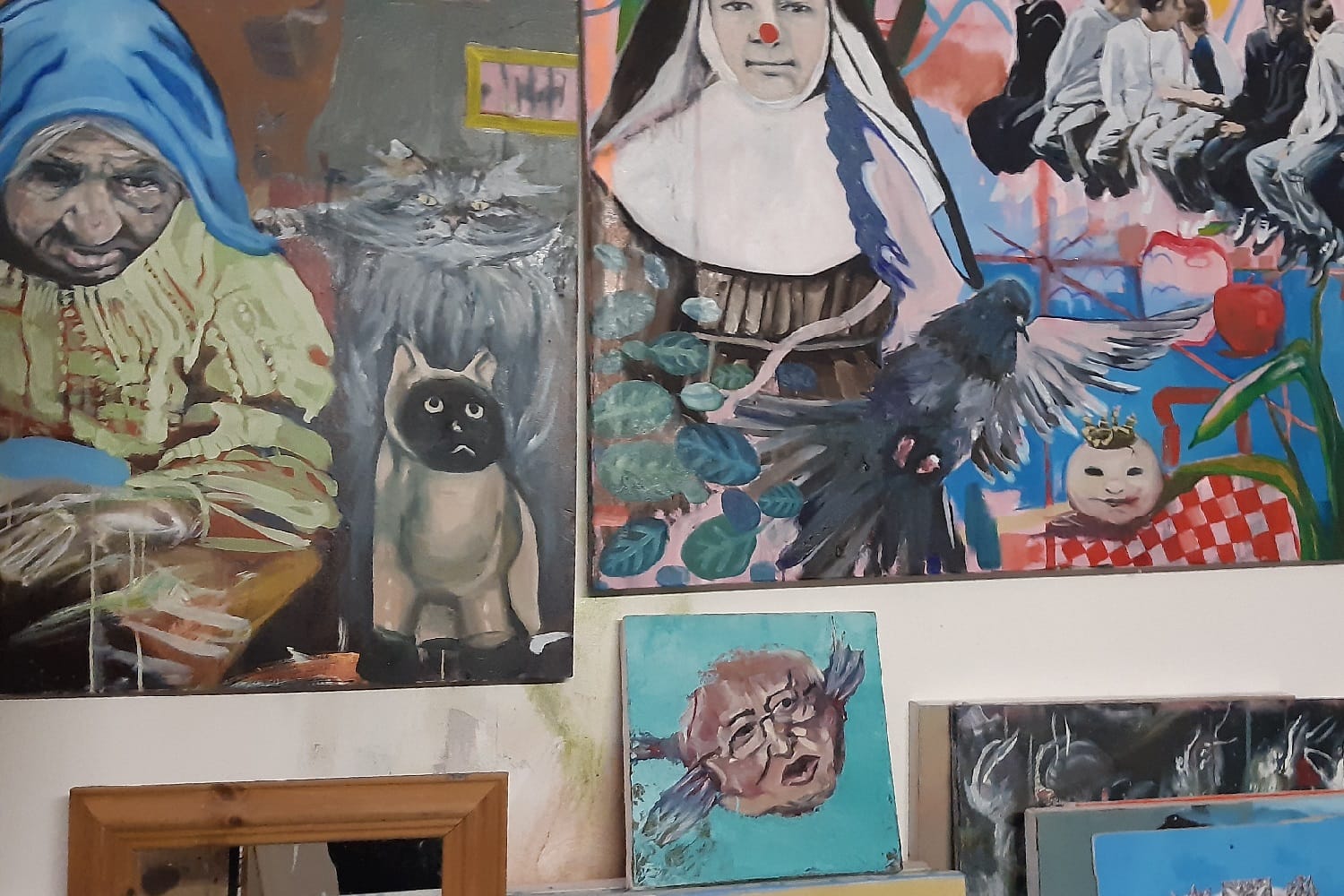What would become of the Civic Offices on Wood Quay if the council relocates?
After The Currency reported the idea of the council moving its HQ, councillors were talking about and thinking through the pros and cons and implications.
Twenty artists are facing eviction from the Richmond Road Studios, but it’s unclear where they could go. Other studios are full – and have long waiting lists.

Louise Butler is unsure, she says, whether to paint or pack up.
If her time in Richmond Road Studios is limited, she wants to make the most of the last few days, she says.
She had only recently moved into one of the windowed spaces and had been hoping to paint in its favourable lighting.
But she and the 19 other artists in Richmond Road face eviction, and now she is torn between her art and figuring out where else might be available to store her canvasses and materials.
Butler has been a member of the studio since 2018. There isn’t an immediate alternative space where she could keep either her finished pieces or works-in-progress, she says.
She lives with her grandmother in Kimmage and that isn’t an option.“Maybe I’ve got enough to go on a guerilla, outdoor exhibition on a trolley, do an auction,” says Butler, jokingly.
Artists’ studios across the city have long waiting lists, say those who manage them, with one currently fielding 300 inquiries, and another with 50 people in the queue for a space.
Few studios in any case are as cheap as Richmond Road, says Butler, and her feeling is that the city is pushing her out.
“It’s like, if your art doesn’t make money, you don’t deserve to make it?” she says. “That’s really the sense I get from a lot of people.”
Butler arrives at the warehouse studio in Fairview on a Friday evening straight from work on the other side of the city, pulling in to the driveway on Convent Avenue as the last of the other resident artists leave for the weekend.
The studios are in the upstairs of an industrial unit, with the ground floor used by a valet operator.
She climbs its staircase and is met by stillness and the cacophony of rain patter on the corrugated roof.
She tends to paint in obsessive bursts, she says, as she walks through a communal kitchen area. “I’d have bursts where I experiment for a month and you know stay late into the night.”
The piece she intends to work on this evening is a darkly comedic apocalyptic scene set against the backdrop of a fiery urban landscape.
Among its cast of characters is a faceless Teletubby, demonic scarecrows, a man on his phone in a beanbag chair and a slug with a human face.
The eventual title Butler will give this piece is “If Only We Had More Influencers”.
Richmond Road Studios began life in 2002, although it was called Pigdog Studios back then.
“It was known for being a starter studio for people like new graduates,” says Maeve Brennan, the studio manager and a member since 2005.
It was far more basic than now, she says. “When I started, at least eight of the interior spaces didn’t have walls. So anybody walking along the corridor could see the person and their belongings.”
During its 20 years, at least 150 artists have worked there, Brennan says.
The studio’s position had been tenuous since the building was first put up for sale in 2014, Butler says. Although both she and Brennan point out that they had a good relationship with the landlord.
In March 2016, an advert showed the two-storey property for sale at €300,000. A representative from the estate agency, North’s Property, stated however, that the building never sold.
According to Butler, in an email sent to elected representatives, the warehouse went into receivership.
On 8 February, a bailiff arrived at the studio, Brennan says, noting that both the bailiff and receivers, Kroll, maintain that they were unaware the building was tenanted.
Then, on 24 March, the studio received an eviction notice, issued on the receiver’s behalf, Butler wrote.
The studio was given seven days to provide evidence that they had a right to occupy the building. Otherwise, in the absence of any proof, they were to agree to vacate the property within 14 days.
Brennan says they were able to prove occupancy using bank statements and contracts co-signed with the previous landlord.
Kroll haven’t responded to an email query, sent 14 April, about the situation with the studio.

In an online petition, the studio asked Dublin City Council for support to secure a six-month extension to their notice of eviction. As of 18 April, the petition had more than 2,700 signatures.
During a meeting of the council’s North Central Area Committee on 11 April, Social Democrats Councillor Catherine Stocker tabled an emergency motion, asking Dublin City Council to buy the building.
Independent Councillor Damien O’Farrell agreed. The council should buy up the first floor and the ground floor, he said. “We have an opportunity now to make 40 spaces.”
City Arts Officer Ray Yeates said the acquisition of a building by Dublin City Council is a “valuation matter”.
“This would have to be taken into account in the whole strategic idea of property and how it’s being treated in the North Central Area, and in that place in particular,” Yeates said. “So I don’t really want to comment on that.”
Yeates warned councillors that there could be unintended consequences if a move was made to buy the building too swiftly. But “certainly, I’m sure it would be great to investigate”, he said.
Derek Kelly, the council’s executive manager said that the cost of upgrades could hamper the motion to purchase the property. “This could run into the millions to acquire and fix up a building to bring it up to a standard.”
“I think a lot of us are trying to figure out if it’s viable to be an artist in Dublin at this moment,” says Adam Gibney, an installation artist and studio member at Richmond Road Studios for eight years.
Anticipating the loss of his studio, Gibney bought a shed to store his work and materials, he says.
“My mam has agreed to put the shed in her back garden,” he says, with an exasperated laugh, while travelling on the train back from an exhibition in Carrick-on-Shannon.
Renting an alternative space is costly, he says, but that’s secondary to simply finding one available place in the city presently.
“Even if I could afford it, I don’t even know if I’d find somewhere,” he says. “That’s the reality.”

Based on the analysis of 2016 census data, Dublin City Council’s Arts Office, as part of an audit on artist workspaces in 2020, estimated that there are roughly 2,500 artists in Dublin.
The same audit, however, also found that between 2010 and 2019, there were only an average of 290 individual artist studios available annually.
“We have an inquiry list for Dublin and there is well over 300 people on that looking for studios,” says Ciara Scanlan, an artist and co-founder of Mart Gallery and Studios.
On average, about one space comes up a month across its six studio buildings in Dublin, which support 150 artists, says Scanlan.
Typically, 40 people respond to a single opening, she says. “You just feel terrible. There’s just such a demand for places for artists and creative people, and lots of places are just closing down.”
Block T on Bow Lane West, near St James’s Hospital, has 25 spaces for 44 artists and “a waiting list of over 50 people currently” says Chris Cullen, the managing director. It gets dozens of enquiries each week, he says.
La Catedral Studios, on St Augustine Street, is made up of 37 spaces, with 24 dedicated to artists, and according to Antonella Scanu, a co-founder, fifteen people are currently on their waiting list.
Both members of the Pallas Projects/Studios in the Liberties and the Ormond Art Studios on Ormond Quay say they are still in high demand – even as they face closure themselves.
“We too have been in a precarious position in the last year with our lease ending,” says Eve Woods, an assistant curator at Pallas Projects. They got a short extension in February, she says.
Ormond Art Studios’ eight spaces are full, says Lorcan Cassidy, a member.
An application to change the use of the art studio to housing was granted permission by council planners on 6 April. If construction happens, the studio will have to relocate, says Cassidy.
Ultimately, says Cullen of Block T, the state must intervene as the number of spaces available to artists in Dublin falls.
“From the walk here into town, I’ll pass several empty state-owned buildings that just are not being put to good use,” he says. “There’s a certain inertia in the civil service or they’re just kind of risk averse.”
A Dublin City Council’s Cultural Infrastructure audit, published December 2020, said there is a need for between 750 and 1,000 studio units.
Acknowledging the inadequate provision of workspaces in the city, the audit recommended the use of less high profile areas and mixed developments as a solution to the deficit.
Dublin City Council has announced some new studios. On 12 April, it put out an open call saying that, if demand is there, it would lease 10 spaces for artists at Artane Place in Dublin 5.
The studios, to be leased from Xestra Asset Management, would be provided by the council at reduced rents, the announcement said.
Stocker, the Social Democrats councillor, said she welcomed this development. “There’s been a recognised underinvestment in the North Central Area, both in terms of grants, facilities and infrastructure.”
That said, if 20 spaces in Richmond Road Studios are lost and 10 new spaces come available, she says, “there is no real net gain”.
At the North Central Area Committee meeting, Yeates, the city arts officer, said that the council would need to be “careful” when assisting the Richmond Road artists.
“Why would we prefer this particular group, if they become homeless so to speak, to what we see as a demand for about 2,000 spaces for citywide,” Yeates said.
Yeates said he encouraged the artists to apply for the spaces at Artane Place. But “we’ll certainly investigate other further spaces”, he said.
“They at least need a temporary place to get to fairly quickly should they be evicted,” he said.
While Butler, the artist in Richmond Road Studios, holds out hope for a six-month extension on the eviction, she still anticipates having to fork out more if the studio must relocate or she has to seek out an entirely new space herself.
“We just need the bloody space,” she says.
Her fellow member, Adam Gibney has more than a trace of exhausted resignation in his voice as he says that the problem is larger than that of a single studio.
Sure, Dublin City Council has said they’re going to look for other spaces, he says. “But something has to happen fast. For new graduates, where do they go? Do they have any options?”
“I’m getting to the stage of, ‘I love being an artist, but how long can I make it work at this rate?’” he says. “You have to wonder what it’s about after a while.”